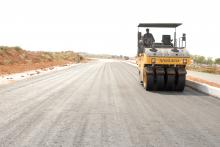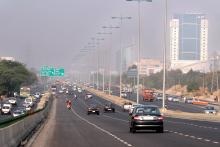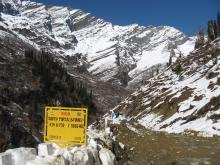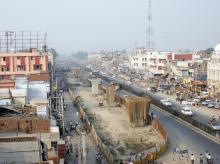
Despite the economic downturn, India looks to be pressing ahead with its major infrastructure projects to further boost its incredible growth. Patrick Smith reports
India, which like most countries has been affected by the current economic climate, although not to the same extent, is pressing ahead with its ambitious highway construction plans.Each week new projects are completed, started or awarded as the nation seeks to improve its transportation requirements. These are needed to meet the aspirations of its people and industry, where inward investment by companies from other countries is increasing rapidly.
India's road infrastructure, which is over 3.3 million km, is the main catalyst for development of key sectors of the economy, and although the National Highways account for only around 2% of the total network, they still total over 66,500km and carry around 40% of the total traffic.
There is little doubt that in the last 10 years or so, India's roads have been vastly improved with a massive investment programme, especially since the
While work here has gone on (some would argue too slowly), a major cause for concern is the country's appalling road safety record. With just 1% of the world's vehicles it accounts for 10% of the world's road accidents. With 100,000 fatalities and at least 2.2 million serious injuries each year India is losing 3% of its GDP to road crashes, while the country is experiencing rapid growth in motorisation.
Again there has been criticism that politicians have not acted effectively enough to tackle the problem, but work has and is being done in an effort to reduce the toll.
For example, a National Road Safety Board (NRSB) and State Road Safety Boards (SRSBs) are being created as a consequence of recommendations in the much-quoted Sundar Committee Report on Road Safety and Traffic Management, chaired by Shri Sundar, former Secretary of the now defunct Ministry of Surface Transport (MOST).
Another move is the setting up of a Committee on Road Safety and Traffic Management, whose remit will be to look after safety issues relating to National Highways. Individual Indian states will also establish similar boards of their own.
Many other organisations are involved in bids to improve road safety including the
With much faster roads, and an increasing number of two and four-wheel vehicles (the low-priced Tata Nano will accelerate this), such work is likely to increase on Indian highways.
The development of the National Highways is the responsibility of the Government of India whose major initiatives through the NHAI are to upgrade and strengthen the routes through various phases of the NHDP.
The first phase comprises mostly of the 5,846km Golden Quadrilateral, linking the major cities of Delhi, Kolkata, Chennai and Mumbai, and the North-South/East-West Corridor/NS-EW (981km), port connectivity (356km) and others (315km). The Golden Quadrilateral is now largely upgraded to four lanes.
Phase II comprises mostly 6,161km of NS-EW Corridor and other National Highways (486km), while Phase III is the upgrading and four-laning of 4,035km of National Highways on a build, operate, transfer (BOT) basis.
Phase V envisages the six-laning of 6,500km of existing four-lane highways on a design, build, finance, operate (DBFO basis), and six-laning of 6,500km including 5,700km of Golden Quadrilateral and other stretches. Phase VI is for the delivery of a total of 1,000km of expressways.
The NHDP intends to see the upgrade of 20,000km of national highways by around mid-2012, and it is understood that bidding for some 40 new Phase III and Phase V projects will start in April.
Indeed, in December 2008, a senior official of Bangalore-based infrastructure company, GMR Group, said it expects to secure Rs. 2,500 crore (approximately US$510 million) worth road projects from NHAI within a year.
"We are very upbeat on the future of highway development in the country and are interested in the new projects which are being awarded by NHAI in phase III and V of NHDP. We have been shortlisted for a number of these projects and are currently evaluating them," said GMR group adviser and director P B Vanchi.
The company was planning to submit its request for proposals (RFPs) for six road projects invited by NHAI for four or six-laning of roads in one each in Rajasthan, Gujrat, Maharashtra, Tamil Nadu and two in Andhra Pradesh. The total cost of these projects is Rs. 8,000-10,000 crore ($1.6 billion).
GMR is undertaking road development projects worth Rs. 2,000 crore ($408 million) in Andhra Pradesh and Tamil Nadu and hoping to commission them within the current financial year.
"These projects are four-laning of the 107km stretch between Adloor and Pochanpalli on NH-7 in Andhra Pradesh at a cost of Rs. 690 crore ($141 million)," said Vanchi.
Another project in Hyderabad on NH-7 is 58km stretch between Shivrampalli/Faruknagar and Jadcherla, with the total outlay of Rs. 490 crore ($100 million).
"This road will be the main corridor for people commuting between Hyderabad city and the new Greenfield Rajiv Gandhi International Airport, which also developed by GMR Group."
Indeed, India is one of the biggest construction sites in the world and it is said that some $330 billion is to be invested by 2015, with the emphasis mainly on road, airport and harbour construction, and also on projects for improving the supply of electricity and drinking water as well as construction of residences.
According to estimates by the Confederation of Indian Industries, the construction industry will grow by an average of at least 10% over the next five years, although this may have to be revised because of the economic situation.
The greatest investments have, and will be, made in road construction and energy. Approximately 10,000km of two-lane roads and 20,000km of four-lane highways are on the shopping list of the Indian government as build-operate-transfer (BOT) projects.
The conclusion in a ashurstinsight (Ashurst LLP, www.ashurst.com) report dated December 2008, and entitled Infrastructure Opportunities, India roads: on the right track, said: "As described above [the report looked at funding methods for highways], the current Indian road market is not without its issues, such as recent court challenges to certain of the bidding rules and, in common with projects worldwide, the increased cost of finance which has called into question the viability of certain projects. However, in the context of the current economic climate, the Government of India has attached a high priority to infrastructure projects in order to further encourage growth. In addition, it is working with various financial and multilateral institutions to provide credit lines for infrastructure projects (of which the road sector forms a part) and intends to utilise approximately US$34bn from its development funds towards the funding of road projects. A motivating factor behind these financial measures is the need to bring down the interest rates on financing for infrastructure projects.
"Given these initiatives, and the long term need for a world class road network in India, the sector continues to offer significant opportunities to both domestic and international investors." ·
India’s Ganga Expressway takes a step closer realisation
One major project scheduled to start this year is the huge Ganga Expressway, the 1,047km project launched by Uttar Pradesh Chief Minister Mayawati after coming to power in 2007.
The project aims to construct an access-controlled eight-lane expressway (the Industrial Development Corridor) running along the Ganga river. It will connect Greater Noida to Ballia to offer high-speed connectivity between the eastern and western boundaries of Uttar Pradesh.
When started, the estimated Rs. 40,000 crore ($10 billion) project is expected to be completed in four years, and while it is the most prestigious project of the Uttar Pradesh government it is also possibly the most controversial.
It is understood that developer, the Jaypee Group, has formally committed itself to the expressway by introducing funds for land acquisition.
The state government is also understood to have finalised the three link expressways connecting to the Ganga Expressway: the Lucknow-Bilhaur, Mirzapur link and the Fatehgarh link.
Even so, the Ganga Expressway could still face problems following the Indian government's decision to declare the Ganga a national river and also to set up the Ganga River Basin Authority to protect the waterway from pollution and other degradation.
Another major project on the horizon is the Mumbai Trans-Harbour Link, which is seen as essential to improve the city's increasing traffic problems.
The envisaged eight-lane, 22km long bridge is in the Government of Maharashtra's development programme, and would be built across Mumbai's harbour.
Over the past decade, increased congestion and population density in Mumbai has had a significant impact on the quality of life. Transportation has been one of Mumbai's biggest problems.
Various projects have been proposed and are currently underway for the development of Greater Mumbai, the Bandra Worli Sea Link and Western Freeway Sea Link Projects (an extension of the Bandra Worili link).
The Bandra Worli Sea Link, expected to be completed by March, is an eight-lane, cable-stayed bridge with pre-stressed concrete viaduct approaches linking Bandra and the western suburbs of Mumbai with Worli and central Mumbai. It will cut travel times by up to one hour.
However, with the population of Mumbai expected to grow at a rate of 3.1% per year to 16 million by 2011, expansion of the city across the mainland would be inevitable to ease congestion. This will have only two equally unpalatable alternatives: expand into the far flung suburbs in the Mumbai Metropolitan Region outside Greater Mumbai or retain the population within the already congested regions, leading to the population density rising well above saturation level, says the Maharashtra State Road Development Corporation.
One way to prevent the existing conditions from worsening is to expand the city on the mainland across the Arabian Sea, providing additional access from Mumbai to the southern half of Navi Mumbai.
The proposed Mumbai Trans Harbour Link will therefore serve not only as an economic gateway to Navi Mumbai but also a panacea to the problems faced by Mumbai.








